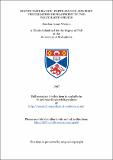Files in this item
Oocyte maturation, fertilization and post-fertilization development in two polychaete species
Item metadata
| dc.contributor.advisor | Bentley, M. G. | |
| dc.contributor.author | Watson, Gordon James | |
| dc.coverage.spatial | 294 p. | en_US |
| dc.date.accessioned | 2018-06-25T16:05:22Z | |
| dc.date.available | 2018-06-25T16:05:22Z | |
| dc.date.issued | 1997 | |
| dc.identifier.uri | https://hdl.handle.net/10023/14566 | |
| dc.description.abstract | Previous studies on Arenicola marina suggest that oocyte maturation is induced by a hormone, from the prostomium, acting directly on the oocyte (Meijer and Durchon, 1977). Results presented here, from studies on British populations of Arenicola marina, show that in this species, oocyte maturation is controlled by two hormonal steps; a prostomial maturation hormone followed by a maturation inducing substance in the coelomic fluid, the Coelomic Maturation Factor (CMF). A reliable in vitro assay for oocyte maturation in A. marina has been adopted distinguishing immature from mature oocytes enabling CMF to be investigated; CMF has a molecular mass greater than 10 kDa, is thermolabile and inactivated by trypsin suggesting a proteinaceous nature. Production of CMF was also investigated; peak production occurs at approximately 2 hours after the injection of homogenised female prostomia. Oocytes require, on average, a minimum time of 20 minutes incubation in CMF to mature and preliminary results suggest calcium may not be necessary for maturation. Immunocytochemical techniques were used to characterise microtubule structures during oocyte maturation and post-fertilization development in Arenicola marina. Different regimes capable of bringing about maturation do not affect the morphology of the meiotic spindle. However, post-fertilization development is slower in oocytes matured in vitro when compared to mature oocytes obtained from naturally spawning females and females injected with homogenised prostomia which then spawn. Changes in microtubule structures in A. defodiens and Nereis virens during post-fertilization have also been partially characterised and these are compared and contrasted with A. marina. The development of a microinjection system will enable intracellular calcium and its role in maturation and fertilization within oocytes to be examined in these polychaetes. | en_US |
| dc.language.iso | en | en_US |
| dc.publisher | University of St Andrews | |
| dc.subject.lcc | QL391.A6W2 | en |
| dc.subject.lcsh | Polychaeta | en |
| dc.title | Oocyte maturation, fertilization and post-fertilization development in two polychaete species | en_US |
| dc.type | Thesis | en_US |
| dc.contributor.sponsor | Biotechnology and Biological Sciences Research Council (BBSRC) | en_US |
| dc.type.qualificationlevel | Doctoral | en_US |
| dc.type.qualificationname | PhD Doctor of Philosophy | en_US |
| dc.publisher.institution | The University of St Andrews | en_US |
This item appears in the following Collection(s)
Items in the St Andrews Research Repository are protected by copyright, with all rights reserved, unless otherwise indicated.

